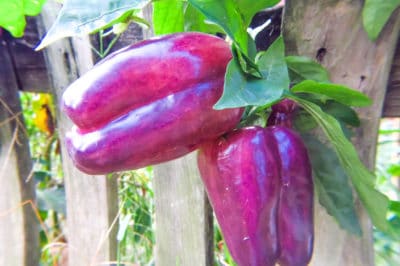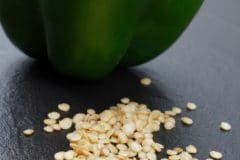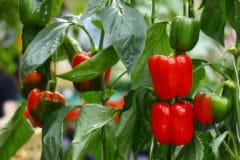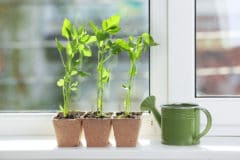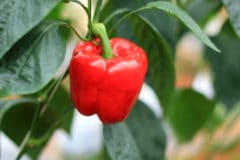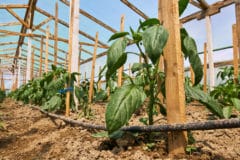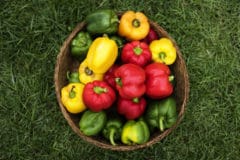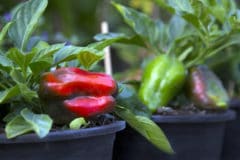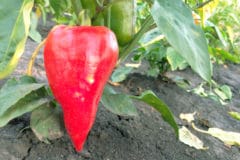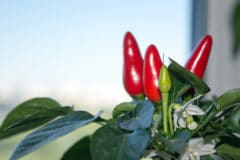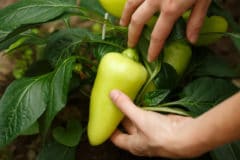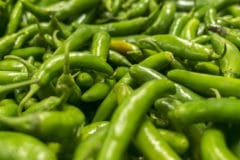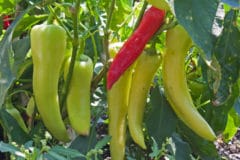Choose a variety
There are dozens of bell pepper varieties. When choosing what to grow, consider the length of season in your region. Some peppers will mature earlier than others making them more suitable for short growing seasons. Here are some popular varieties.
Full-sized bell peppers
- California Wonder: The standard red bell pepper. This cultivar is an heirloom that ripens to red. 55 days to green peppers, and 70 days to red peppers. These are great for grilling and stuffing.
- Yolo Wonder: A common heirloom green bell. Takes 80 days to reach maturity. Very productive plants with foliage that reduces sunscald. Perfect for hot climates.
- Canary Bell: A medium to full sized bell that ripens to bright yellow. Sets fruit early and produces all year (70 days). Resistant to Tobacco Mosaic Virus. Superb sweet flavor.
- Horizon Bell: A medium to full sized bell that ripens to orange. Takes 73 days, and produces very sweet gourmet fruits.
- Lilac Bell: Crisp and juice medium-sized fruits. 73-day peppers turn a brilliant purple before ripening to red. Excellent in relish.
Miniature bell peppers
- Miniature chocolate bell: Bite-sized bells that ripen to a milk chocolate color. It’s a 90-day heirloom plant that is massively productive. These miniature peppers are perfect for stuffing.
- Albino bullnose: small to mid-sized cream colored bells. These are early 65-day dwarf plants. Perfect for cold climates or containers.
- Miniature yellow bell: two-inch fruits that ripen to bright yellow. These are 90-day plants, extremely productive. Good flavored heirloom.
- Miniature red bell: This 60-day early bird is perfect for short growing seasons. Very sweet bite-sized red bells are perfect for stuffing. Very productive plants.
Planting sweet peppers
In USDA zones 11 and above peppers are perennial plants that can be planted any time of the year. In the tropics sow seed into a well-cultivated garden bed and thin them out once sprouted.
In cooler climates start peppers seeds indoors 8-12 weeks before the last frost date. Pay attention to the number of frost-free days in your area. Peppers are long-season plants that stay in the ground all year. Upon setting fruit, they continue to produce until cooler temperatures send them into dormancy.
Use a peat or coir based potting soil with perlite or vermiculite to start seeds. The soil should be absorbent and well-draining. Keep germinating seeds and seedlings within a temperature range of 65-75°F (18-24°C). They will sprout within 5 days of planting.
Caring for seedlings
Upon sprouting, immediately move seedlings under lights. Fluorescent lights work well and should be placed four inches from the tops of plants. Raise the lights as the plants grow to maintain this distance. Extra lighting prevents seedlings from elongating which results in gangly plants that require additional staking.
Avoid over-watering seedlings or wetting the foliage. Bottom watering is recommended for pepper plants. Place a fan in the seedling room to strengthen stalks and prevent moisture build-up.
Transplant seedlings two weeks after the last frost date. Only transplant after acclimating seedlings to outdoor conditions.
How to acclimate seedlings
Planting directly from indoors to the garden will cause stunting. Seedlings must acclimate to direct sunlight, wind, fluctuating temperatures, and precipitations.
Begin by taking plants outside into dappled light for half an hour. Slightly increase the amount of time spend outside each day. Increase the plant’s exposure to direct light, wind, precipitation, and nighttime temperatures.
The process takes a week or two. Peppers are ready for transplant when they show no signs of stress after being outside for 24 hours. Give pepper plants plenty of room to grow. Space plants one to two feet apart in the garden.
Caring for green pepper plants
Top off outdoor planting beds with three to six inches of compost. You can work it into the soil or use it as a mulch. This will feed the plants over time as they grow. When the plants set fruit, you can feed them again with some organic liquid fertilizer or compost tea.
Stick to a regular watering schedule. Pepper plants are prone to stunting when over or under watered. Soil should be kept moist but not wet. Water between one and two inches per week and adjust for natural precipitation. Everyday watering may be necessary during hot and dry days.
Ground watering systems like drip irrigation save water and keep pepper plant foliage from getting wet. Wet foliage invites harmful fungus and bacteria.
Sweet pepper companions
Sowing companion plants alongside sweet peppers improves overall garden health. Aromatic herbs keep pests away and attract beneficial insects. Some of the best herbs to plant near peppers are:
- Basil
- Chives
- Garlic
- Dill
- Marjoram
- Rosemary
Low growing crops will help to crowd out weeds while providing an additional harvest. They don’t shade out pepper plants because of their low growth and are suitable for cooler climates. Here are some root crops to grow with your peppers.
- Parsnips
- Squash
- Beets
- Radish
- Carrots
Harsh midday sun can damage pepper plants in hot climates. Consider planting taller companions that will provide some needed shade when the season heats up.
- Leeks
- Chard
- Corn
- Asparagus
- Lovage
Pests and Disease
Blossom End Rot: This bacterial disease affect pepper plants that are experiencing a calcium deficiency. Boost calcium in the soil by adding crushed oyster shells or lime. Avoid soluble nitrogen-heavy fertilizers, which can exacerbate this problem.
Aphids: Aphids are small green insects that cluster on the undersides of leaves and feed off of foliage. In a biodiverse ecosystem, aphids usually clear up by themselves. Other options include purchasing colonies of ladybugs and praying mantis.
Cucumber Mosaic Virus: This virus is spread mainly by aphids and other insects. If this disease is common in your region, plant resistant varieties. Plant tall border hedges to separate peppers from potential contaminants.
Harvest and storage
All bell peppers start out green. As they mature they will reach their final bright shade. Harvest bell peppers at any stage desired. Green peppers are just young red, yellow, or red bell peppers. Harvest some green and leave others to fully mature on the plant.
Ripe peppers pull easily from the plant. They appear plump, glossy, and brightly colored. Use a sharp knife or scissors to cut the stem of green peppers. This will avoid damaging the plant stalk or roots.
Store fresh peppers in the fridge for up to two weeks. Preserve them further in various ways including canning, freezing, drying, and pickling. Paprika is a powder made from dried bell peppers that adds color and flavor to any dish.
